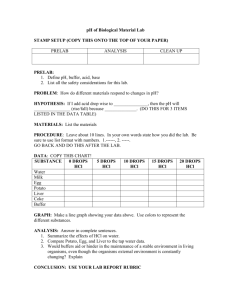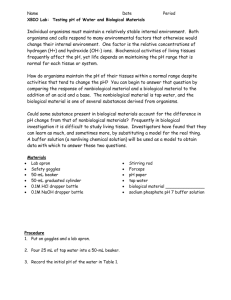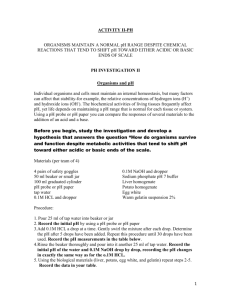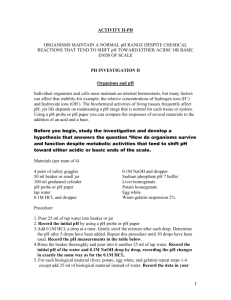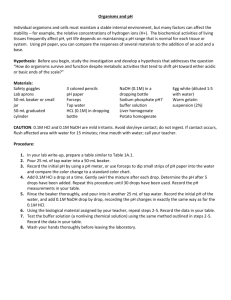Buffers - BU Blogs
advertisement
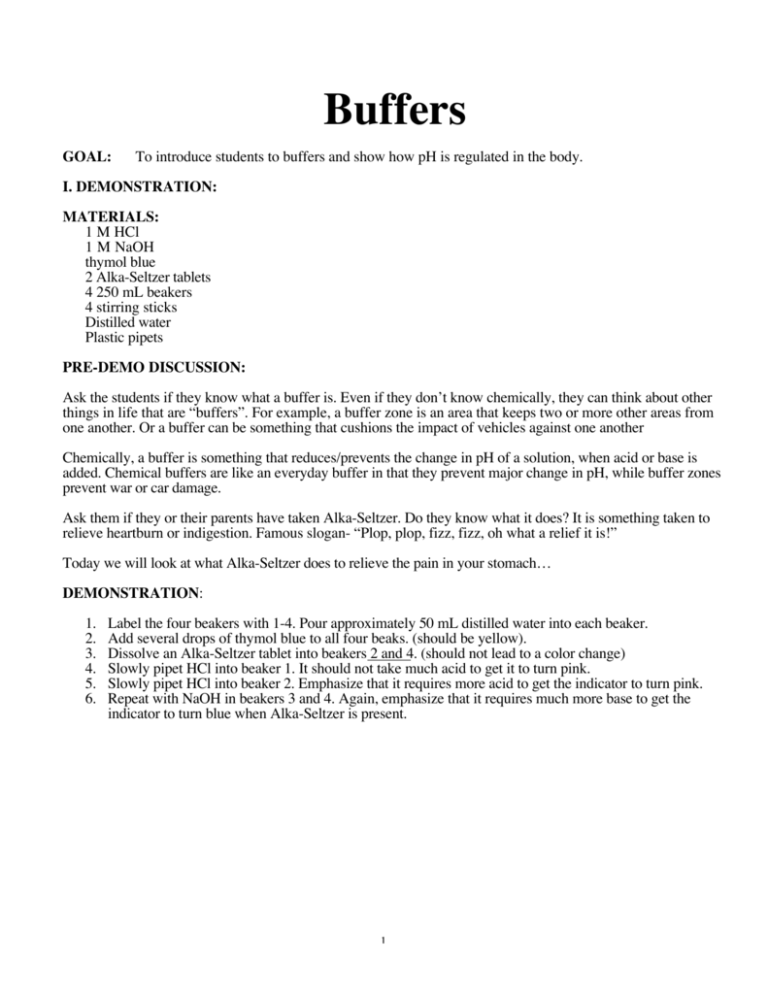
Buffers GOAL: To introduce students to buffers and show how pH is regulated in the body. I. DEMONSTRATION: MATERIALS: 1 M HCl 1 M NaOH thymol blue 2 Alka-Seltzer tablets 4 250 mL beakers 4 stirring sticks Distilled water Plastic pipets PRE-DEMO DISCUSSION: Ask the students if they know what a buffer is. Even if they don’t know chemically, they can think about other things in life that are “buffers”. For example, a buffer zone is an area that keeps two or more other areas from one another. Or a buffer can be something that cushions the impact of vehicles against one another Chemically, a buffer is something that reduces/prevents the change in pH of a solution, when acid or base is added. Chemical buffers are like an everyday buffer in that they prevent major change in pH, while buffer zones prevent war or car damage. Ask them if they or their parents have taken Alka-Seltzer. Do they know what it does? It is something taken to relieve heartburn or indigestion. Famous slogan- “Plop, plop, fizz, fizz, oh what a relief it is!” Today we will look at what Alka-Seltzer does to relieve the pain in your stomach… DEMONSTRATION: 1. 2. 3. 4. 5. 6. Label the four beakers with 1-4. Pour approximately 50 mL distilled water into each beaker. Add several drops of thymol blue to all four beaks. (should be yellow). Dissolve an Alka-Seltzer tablet into beakers 2 and 4. (should not lead to a color change) Slowly pipet HCl into beaker 1. It should not take much acid to get it to turn pink. Slowly pipet HCl into beaker 2. Emphasize that it requires more acid to get the indicator to turn pink. Repeat with NaOH in beakers 3 and 4. Again, emphasize that it requires much more base to get the indicator to turn blue when Alka-Seltzer is present. 1 DISCUSSION: Have the student recall what it takes to get indicator to turn to pink or blue (acidic solutions turn pink, and basic ones turn blue). Beakers 2 and 4 did not turn to acidic/basic solutions as quickly, because Alka-Seltzer was present. What does Alka-Seltzer do? It acts as BUFFER. A BUFFER is substance that helps to maintain a certain pH. In the human body, if too much acid or base is present, discomfort (heartburn) or damage (ulcers) can occur. Alka-Seltzer will keep the pH at the proper pH and prevent those things from happening. The ingredients in Alka-Seltzer are sodium bicarbonate and sodium citrate. NaHCO3 (sodium bicarbonate, a weak acid) acts to neutralize base: NaHCO3 + NaOH ! Na2CO3 + H2O Na3C3H5O7 (sodium citrate, a weak base) acts to neutralize acid: Na3C3H5O7 + HCl ! H3C3H5O7 + NaCl One may wonder why Alka-Seltzer fizzes when you dissolve it… In Alka-Seltzer, the following reaction occurs, when it is dissolved in water: 3 NaHCO3 + H3C3H5O7 ! Na3C3H5O7 + 3 CO2 (g) + 3 H2O (The CO2 gas is what causes Alka-Seltzer to bubble when it dissolves in water!) Now in lab, students will explore the buffering ability of various household items… 2 II. GROUP LAB: TESTING BUFFERING ABILITY OF HOUSEHOLD ITEMS MATERIALS: 14 50 mL beakers 0.5 M HCl 0.5 M NaOH well trays Bottles with various household chemicals/foods Stirring sticks Distilled water Plastic pipets pH meter **NOTE** The pH Meters are very expensive and susceptible to breaking. Be very careful with them!! Have the student volunteers pour the solutions and add the acid/base, but YOU should handle the pH meters at all times. LABORATORY: 1. Ask the class for two to three volunteers. Effect of Adding Acid: 2. Have one of the volunteers pour ~25 mL of bottle #1 (Bufferin) into a 50 mL beaker. 3. Test the pH of the Bufferin solution and report it to the class. They have blank Results Table sheets, so should record the number in their table. 4. Have one of the volunteers add 10 drops of 0.5 M HCl to solution #1. 5. Test the pH of the solution and report it to the class. 6. Have one of the volunteers add 10 more drops (20 total) of 0.5 M HCl to the solution. 7. Test the pH of the solution and report it to the class. 8. Rinse off the pH probe with water between each solution!! 9. Repeat these steps with solutions 2-7 to study the effect of adding acid to each solution. Effect of Adding Base: 10. Have one of the volunteers pour ~25 mL of bottle #1 (Bufferin) into a 50 mL beaker. 11. Have one of the volunteers add 10 drops of 0.5 M NaOH to solution #1. 12. Test the pH of the solution and report it to the class. 13. Have one of the volunteers add 10 more drops (20 total) of 0.5 M NaOH to the solution. 14. Test the pH of the solution and report it to the class. 3 15. Rinse off the pH probe with water between each solution!! 16. Repeat these steps with solutions 2-7 to study the effect of adding base to each solution. 17. Once you are done with the pH probe, rinse it off really, really well with water before replacing it into the buffer solution screwcap bottle. 18. After you have studied acid and base effect with all 7 solutions, ask the students to tell you which solutions had the largest/smallest changes in pH when acid/base was added. Their results should look something like those below. 19. To aid in the discussion, write the class results on the chalkboard, if you have time. Results Table Material Tested pH after 20 drops of ACID 3.2 pH after 10 drops of BASE 3.4 pH after 20 drops of BASE 3.6 Total pH change 3.2 pH after 10 drops of ACID 3.2 3. egg white 9.5 9.0 8.3 9.8 9.9 1.6 4. gelatin 5.7 5.1 4.8 7.6 9.2 4.4 5. potato 6.1 6.0 5.9 6.3 6.7 0.8 6. soda water 4.5 2.4 2.6 4.7 4.9 2.3 7. tap water 6.9 2.91 2.53 10.83 11.08 8.55 1. Bufferin Original pH 0.2 2. celery 4 DISCUSSION: How do you decide which is the best buffer? The one with the smallest pH change is the best buffer. Depending on what pH you want though, it may be better to use a certain one. For example, if you wanted to have a pH stay around 6.1, you would use a potato as a buffer. Although it doesn’t have the smallest pH range, it does a good job of keeping the pH around 6, while aspirin or Bufferin keep the pH around 3. Order should be: Bufferin > potato > soda water > egg white > gelatin > tap water Why is potato such a good buffer? It grows in the ground, so will see a lot of harsh conditions (variations in pH due to rain, soil, pollution, etc.) If it does not have a mechanism to keep those harsh conditions from changing the internal pH of the potato, it should die whenever it does not have ideal conditions. Buffering ability of potato enables it to survive even when pH is changing all around it. Can you name other household items that are likely to be good buffers? Yeast (growing organism), liver (body part), mushroom, celery (pretty much any vegetable), Consider the pH of human blood… The ideal pH in human blood is 7.4. When you exercise, H+ is released into the blood. As we know, the addition of H+ to the blood will decrease its pH (make it more acidic). If the pH of blood drops below 6.8 death may occur. Luckly, in the blood, there are several types of buffer systems: phosphate (H2PO4-/HPO42-), bicarbonate (H2CO3/HCO3-), and proteins (variety of weak acids and bases). All of these buffer work together to maintain the proper pH and keep us alive. For example, where is what bicarbonate can do: H+ + HCO3- ! H2CO3 Bicarbonate will react with the proton to form carbonic acid, which can then become water and carbon dioxide. Reaction of the H+ with carbonate keeps the pH from decreasing rapidly (and keeps us alive!) If there is a decrease in the concentration of H+ in the blood, the following reaction will occur to keep the pH of the blood from increasing: H2CO3 ! H+ + HCO3Carbonic acid in the blood will be “deprotonated” (loss an H+) to form bicarbonate. This will decrease the pH of the blood, keeping it in the proper range. The phosphate buffer works in a similar way. 5 Household Buffers Results Sheet Name_________________________ a. In the blank table below, record the pH of each solution. b. Report the pH of each solution after 10 and 20 drops of 0.5 M HCl have been added to each solution. c. Report the pH of each solution after 10 and 20 drops of 0.5 M NaOH have been added to each solution. d. Calculate the total pH change by subtracting the pH after 20 drops of acid have been added from the pH after 20 drops of base have been added. Results Table Material Tested Original pH pH after 10 drops of ACID pH after 20 drops of ACID 1. Bufferin 2. celery 3. egg white 4. gelatin 5. potato 6. soda water 7. tap water 6 pH after 10 drops of BASE pH after 20 drops of BASE Total pH change Questions: 1. Which is the best buffer? Which is the worst buffer? 2. Why is the potato such a good buffer? 3. What are other foods that are likely to be good buffers? 4. In human blood, the phosphate buffer system works to maintain the pH of 7.4. The phosphate buffer is a mixture of H2PO4- (dihydrogen phosphate) and HPO42- (hydrogen phosphate). Which of these species will react with H+ when there is too much acid present in the blood? Which of them will react when there is not enough H+ present? Write the chemical reactions for each of these cases. 7

